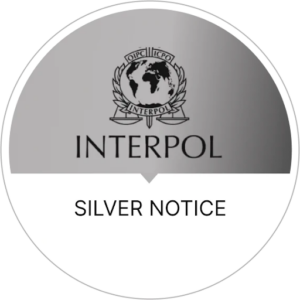On January 10, 2025, Interpol took an important step in combating economic crime by issuing the first Silver Notice. This event was significant as this notice is aimed at identifying and blocking criminal assets used by offenders for money laundering and other illegal activities. Let’s take a look at what the Silver Notice is, its purpose, and Italy’s role in this process.
What is Silver Notice?
Silver Notice — a new type of notification that Interpol uses to draw the attention of law enforcement agencies and other participants in the fight against crime to criminal assets. Unlike other notifications, such as Red Notice, which are aimed at apprehending criminals, Silver Notice focuses specifically on assets, such as illegal money, real estate, and other resources used in criminal schemes.
The Objective of the Silver Notice
The main goal of the Silver Notice is to enhance coordination between law enforcement agencies of different countries in combating criminal schemes and transferring funds to legal markets. The notice provides information about criminal assets that may be concealed or used for illegal activities. It allows for the acceleration of investigation processes and the freezing of such assets. One of the primary objectives is to prevent the use of financial resources for further crimes, such as terrorism, drug trafficking, and money laundering.
Italy’s Role in the First Silver Notice
Italy became the first country to provide information for the issuance of the first Silver Notice. The notice, requested by Italy, contains a request to provide information about assets belonging to a high-ranking member of the mafia. This country is actively combating criminal groups involved in money laundering and other financial crimes. Thanks to the involvement of Italian law enforcement agencies, the process was expedited, and information about criminal assets was transferred to the international level.
Scope and Functionality of Silver Notices and Diffusions
Silver Notice is a notification that Interpol uses to draw the attention of law enforcement agencies to criminal assets. These include money, real estate, and other resources that can be used for money laundering or other criminal purposes.
Unlike other notices, a Silver Notice is not aimed at arrests but serves for the exchange of information between countries. This allows for quicker action in case such assets are identified, ensuring their freezing and preventing their use in criminal schemes. Silver Notices, in turn, can be disseminated through systems called Diffusions, which enable the distribution of information about criminal assets worldwide.
Development and Approval of the Silver Notice Pilot
Silver Notice — a new addition to the system of color-coded notices and diffusions of Interpol, which allows countries to exchange information worldwide. Currently, the project is in the pilot stage, covering 52 countries and territories, and will last at least until November 2025.
In 2023, at the 91st General Assembly of Interpol in Vienna, resolution GA-2023-91-RES-11 was adopted, which mandated the development of a pilot project for Silver Notice and diffusions. The resolution tasked the Expert Working Group on Asset Tracing, in collaboration with the General Secretariat, to determine the format and conditions of the project, as well as security measures.
Silver Notice notifications will be sent to all 196 member countries of Interpol, while diffusions will be sent to selected countries. The General Secretariat will review each notification and diffusion to ensure they comply with the organization’s rules and are not used for political purposes that violate Interpol’s Constitution. During the pilot phase, excerpts from the notifications will not be published on Interpol’s official website.
Future of the Silver Notice Pilot Program
The future of the Silver Notice program looks promising. It is expected that participants in the pilot project will be able to request up to 500 notices and diffusions, with the number being evenly distributed among all participating countries. The list of countries and territories involved in the project includes 52 states, among them Algeria, Argentina, Australia, Belgium, Brazil, China, France, Italy, India, Kazakhstan, Russia, the USA, and others.
The success of the pilot project can serve as a foundation for further development of the program and the implementation of additional mechanisms for blocking and confiscating criminal assets. In the future, this will help create a safer global financial system where criminal resources will be under constant control of law enforcement agencies.



